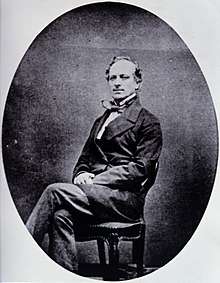Francis Rynd
Francis Rynd AM, MRCS, MRIA (1801–1861) was an Irish physician, known for inventing the hollow needle used in hypodermic syringes.

Background
Rynd was born in Dublin, Ireland, in 1801 to James Rynd and his third wife Hester Fleetwood, of Ryndville Castle, County Meath and Derryvolan, County Fermanagh, Ireland, respectively. Rynd attended medical school at Trinity College, Dublin, where he was reputed to be a "wayward" student, known for his busy social life and love of fox hunting.[1][2][3]
Career
Rynd worked at the Meath Hospital in Dublin.[4] At the Meath Hospital he trained under surgeon Sir Philip Crampton.[5]
Rynd became a member of the Royal College of Surgeons in 1830. In 1836 he took a surgical post in the Meath Hospital working alongside William Stokes and Robert James Graves. Dr Rynd, who had a lucrative private practice, also served as medical superintendent of the Mountjoy Prison.
Rynd was a member of the exclusive Kildare Club in Dublin.
Hypodermic needle
In a 12 March 1845 article in the Dublin Medical Press, Rynd outlined how he had injected painkillers into a patient with a hypodermic syringe in on 3 June 1844:[6][7]
"Margaret Cox, aetat. 59, of spare habit, was admitted into hospital, May 18, 1844, complaining of acute pain over the entire of left side of face, particularly in the supraorbital region, shooting into the eye, along the branches of the portio dura in the cheek, along the gums of both upper and lower jaw, much increased in this situation by shutting the mouth and pressing her teeth close together, and occasionally darting to the opposite side of the face and to the top and back of her head. On the 3rd of June a solution of fifteen grains of acetate of morphia, dissolved in one drachm of creosote, was introduced to the supra-orbital nerve, and along the course of the temporal,malar, and buccal nerves, by four punctures of an instrument made for the purpose. In the space of a minute all pain (except that caused by the operation, which was very slight) had ceased, and she slept better that night than she had for months. After the interval of a week she had slight return of pain in the gums of both upper and under jaw. The fluid was again introduced by two punctures made in the gum of each jaw, and the pain disappeared. After this the pain did not recur, and she was detained in hospital for some weeks, during which time her health improved, her sleep was restored, and she became quite a happy looking person. She left the hospital on the 1st of August in high spirits, and promised to return if she ever felt the slightest pain again. We conclude she continues well, for we have not heard from her since."
Personal life and family
Francis married Elizabeth Alley, daughter of Alderman John Alley who served as Lord Mayor of Dublin, and had three sons and daughters. Rynd named one of his sons Philip Crampton Rynd after his mentor Sir Philip Crampton.
Rynd's half brother, Goodlatte Rynd, Esquire was killed at the Battle of Salamanca in 1812. Francis Rynd's niece by Goodlatte and Lady Harriet Jane Brown, née Temple, Lady Maria Rynd, married Pedro José Domingo de Guerra in 1840, then Bolivia's Consul at Paris.[10] Maria moved to South America and went on to become first lady of Bolivia in 1879. Her grandson, Jose Gutierrez Guerra, was president of Bolivia between 1917 and 1920.
Rynd's nephew James Alexander Porterfield Rynd was an Irish chess master and barrister.
Rynd died in Dublin in 1861 at the age of 60, after suffering a heart attack.[2]
Notes
- Ormsby L: Medical History of the Meath Hospital and County Dublin Infirmary. Dublin, Fannin & Co, 1888.
- Thu, Dec 5, 2002, 00:00 (2002-12-05). "The Irish doctor who invented the syringe". Irishtimes.com. Retrieved 2019-05-05.CS1 maint: multiple names: authors list (link)
- Francis Rynd (1801-1861). JAMA. 1970;212(7):1208
- Francis Rynd – inventor of the hypodermic syringe www.irelandcalling.ie
- "Francis Rynd". Dublin Quarterly Journal of Medical Science. Fannin and Company. 33: 254. 1862.
- Rynd F: Neuralgia - introduction of fluid to the nerve. Dublin Med Press. 13:167-168, 1845.
- Huth, Edward J.; Murray, T. J., eds. (2006). Medicine in Quotations: Views of Health and Disease Through the Ages (2nd ed.). American College of Physic. p. 130.
- "Irish doctor who invented the modern injection remembered". Thejournal.ie. 2012-02-17. Retrieved 2019-05-05.
- Pates R, McBride A, Arnold K. Injecting Illicit Drugs. Wiley-Blackwell; 2008.
- "Announcements". The Gentleman's Magazine. John Bowyer Nichols and Son. 168: 89. 1840.
Published works
- Pathological and Practical Observations on Strictures: And Some Other Diseases of the Urinary Organs (1849)
References
- Thomas Dormandy, The Worst of Evils: The Fight Against Pain, p. 258 (2006)
- Michael Windelspecht, Groundbreaking Scientific Experiments, Inventions, and Discoveries of the 19th Century, p. 155 (2003)
- Mary Mulvihill, Ingenious Ireland: A County-by-County Exploration of the Mysteries and Marvels of the Ingenious Irish p. 35 (2002)
- Sean J. Connolly, The Oxford companion to Irish history, p. 355 (1998)
- Walter Reginald Bett, The History and Conquest of Common Diseases p. 145 (1954)
- Fielding Hudson Garrison, An Introduction to the history of medicine p.708 (1921)